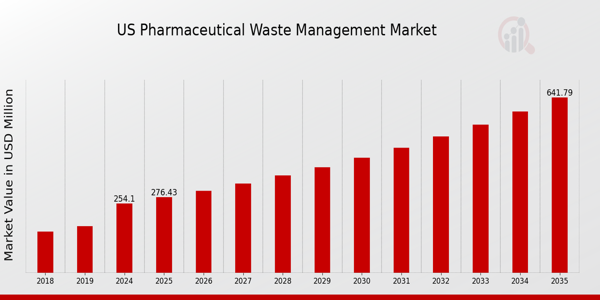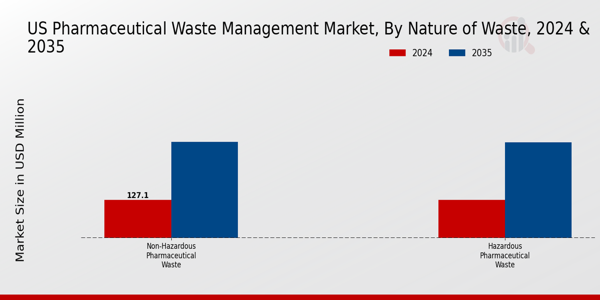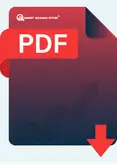US Pharmaceutical Waste Management Market Overview
As per MRFR analysis, the US Pharmaceutical Waste Management Market Size was estimated at 247.8 (USD Million) in 2023. The US Pharmaceutical Waste Management Market Industry is expected to grow from 254.1(USD Million) in 2024 to 641.8 (USD Million) by 2035. The US Pharmaceutical Waste Management Market CAGR (growth rate) is expected to be around 8.788% during the forecast period (2025 - 2035).
Key US Pharmaceutical Waste Management Market Trends Highlighted
The US Pharmaceutical Waste Management Market is currently influenced by several significant trends that reflect growing concerns over environmental sustainability and public health. Key market drivers include stringent regulations imposed by the Environmental Protection Agency (EPA) and state-level agencies, mandating proper disposal methods for hazardous pharmaceutical waste.
These regulations encourage healthcare facilities, including hospitals and pharmacies, to adopt comprehensive waste management strategies that minimize environmental impact. Additionally, the rise in the volume of pharmaceutical waste generated, predominately due to the increase in prescription medications, has necessitated improved waste handling processes.
Opportunities to be explored in this market include the development of advanced waste-to-energy technologies and innovative recycling solutions that can further mitigate waste while recovering valuable materials. Companies are also focusing on educational campaigns for proper drug disposal methods to increase community involvement, thus reducing the risk of pharmaceuticals entering the water supply.
Trends in recent times indicate a shift towards digitization in waste management systems, with healthcare facilities investing in software solutions for better tracking and reporting of waste disposal metrics. Such technology facilitates compliance with regulatory requirements and enhances operational efficiency. Increasing awareness around the dangers of improper pharmaceutical disposal is pushing for collaborative initiatives between manufacturers, healthcare providers, and governmental bodies.
Overall, the US Pharmaceutical Waste Management Market is evolving rapidly, reflecting a urgent need for enhanced practices aimed at environmental protection and public health safety.

Source: Primary Research, Secondary Research, Market Research Future Database and Analyst Review
US Pharmaceutical Waste Management Market Drivers
Increasing Regulations on Pharmaceutical Waste Disposal
In the United States, there has been a significant increase in federal and state regulations governing the disposal of pharmaceutical waste. The Environmental Protection Agency (EPA) and various state agencies have implemented strict guidelines as part of the Resource Conservation and Recovery Act, mandating that healthcare providers properly manage pharmaceutical waste. This regulatory framework is becoming increasingly stringent, with fines and penalties for non-compliance. For instance, a 2021 report indicated that nearly 50 percent of hospitals faced non-compliance issues with hazardous waste regulations, encouraging them to seek out efficient waste management solutions.
As regulations continue to evolve, the US Pharmaceutical Waste Management Market Industry is expected to see a considerable surge in demand for compliant waste management services.
Growing Awareness of Environmental Impact
There is a growing awareness concerning the environmental impact associated with improper disposal of pharmaceutical waste among both healthcare providers and consumers in the United States. According to a 2020 study published in the Journal of the American Medical Association, an estimated 90 tons of unused or expired pharmaceuticals are generated by hospitals and clinics in the US each day. Public pressure and advocacy groups, such as the National Institute of Health, are increasingly emphasizing the need for responsible disposal methods to prevent contamination in water sources and ecosystems.
This heightened awareness is driving healthcare facilities to adopt better waste management practices, directly contributing to the growth of the US Pharmaceutical Waste Management Market Industry.
Rapid Growth in Biopharmaceutical Development
The biopharmaceutical sector in the United States has been expanding rapidly, with an estimated growth rate of approximately 9 percent annually over the next few years. As more biopharmaceutical products enter the market, there is a corresponding increase in pharmaceutical waste generated from clinical trials and production processes. Organizations such as the Biotechnology Innovation Organization play a crucial role in facilitating this growth, resulting in heightened scrutiny surrounding the disposal of these products.
Given that improper disposal can lead to environmental hazards, this trend is pushing healthcare providers and pharmaceutical companies to implement more efficient waste management solutions, thereby boosting the US Pharmaceutical Waste Management Market Industry.
US Pharmaceutical Waste Management Market Segment Insights
Pharmaceutical Waste Management Market Nature of Waste Insights
The Nature of Waste segment within the US Pharmaceutical Waste Management Market plays a pivotal role in how pharmaceutical waste is handled and processed. This segment is primarily categorized into two main types: Non-hazardous Pharmaceutical Waste and Hazardous Pharmaceutical Waste. Non-hazardous Pharmaceutical Waste typically includes items like empty medication bottles, packaging materials, and other non-contaminated products, which necessitate simpler disposal methods. This category is essential for promoting environmentally friendly practices and supports recycling initiatives that aim to reduce landfill waste.
On the other hand, Hazardous Pharmaceutical Waste encompasses potentially harmful substances that can pose risks to public health and the environment if not properly managed. This type of waste includes expired medications, contaminated sharps, and other toxic substances requiring specialized disposal methods to mitigate risks. The significance of Hazardous Pharmaceutical Waste cannot be overstated, as improper disposal can lead to soil and water contamination, affecting ecosystems and public health. Regulatory compliance is critical in managing both categories of waste, and various federal and state regulations dictate how to process these materials safely.
The US government continues to implement stringent guidelines to ensure the safe management of pharmaceutical waste, reflecting the need for effective strategies to protect the environment and human health. As the healthcare sector evolves, the demand for comprehensive waste management solutions in the pharmaceutical industry is anticipated to grow, driven by increased regulations, awareness about environmental impact, and the need for efficient, safe disposal methods.
The growth in this market segment is accompanied by the development of innovative technologies aimed at improving waste segregation, collection, and disposal practices, enabling healthcare facilities to manage their waste more effectively while adhering to regulatory standards. The insights within the Nature of Waste segment highlight the complexities and importance of proper pharmaceutical waste management in ensuring a sustainable and eco-conscious future for the US healthcare industry.

Source: Primary Research, Secondary Research, Market Research Future Database and Analyst Review
Pharmaceutical Waste Management Market Type of Waste Insights
The US Pharmaceutical Waste Management Market focuses on the management of various types of waste generated within the pharmaceutical sector, which includes Over the Counter Waste, Non-controlled Prescription Drugs, Controlled Drugs, and Hazardous Drugs. Over the Counter Waste, a significant component, includes products widely available without prescriptions, making its proper disposal essential to prevent environmental contamination and misuse. Non-controlled Prescription Drugs represent a notable portion as well, encompassing prescriptions that are not classified as controlled substances but still require careful management to mitigate potential health risks.
Controlled Drugs, which are strictly regulated due to their potential for abuse, present unique challenges in waste management that necessitate stringent practices to ensure compliance with regulations and safeguard public health. Hazardous Drugs, known for their toxicity and potential harm, demand specialized waste management solutions to protect healthcare workers and the environment. The increasing awareness of safe disposal methods and regulations is driving innovations in waste management processes, creating opportunities for growth in the market. Understanding the dynamics of these waste types is crucial for mitigating risks and enhancing sustainability within the US pharmaceutical industry.
Pharmaceutical Waste Management Market Source of Waste Generation Insights
The Source of Waste Generation segment in the US Pharmaceutical Waste Management Market encompasses various entities such as Hospitals, Clinics and Physicians’ Offices, Pharmaceutical and Biotechnology Companies, and Pharmacies. Hospitals represent a significant portion of pharmaceutical waste generation as they handle various medications and treatments, resulting in large volumes of waste that need proper disposal to comply with regulatory standards. Clinics and Physicians’ Offices contribute to this waste primarily through unused or expired medications, making their role crucial in ensuring proper waste management practices are implemented.
Pharmaceutical and Biotechnology Companies are also essential, as they generate waste through production processes and product development, reinforcing the need for effective waste management strategies to mitigate environmental impact. Pharmacies further add to the landscape by generating waste from returned medications and expired stock, emphasizing the overall importance of the Source of Waste Generation segment in maintaining public health and environmental safety. This segment is driven by increasing regulations, rising awareness about the environmental impacts of pharmaceutical waste, and a growing need for sustainable waste management solutions across the industry.
In summary, the diversity of waste sources underlines the significance of tailored waste management approaches to address the unique challenges faced by each entity.
US Pharmaceutical Waste Management Market Key Players and Competitive Insights
The US Pharmaceutical Waste Management Market has gained significant traction due to increasing regulatory scrutiny regarding the disposal of hazardous waste and the growing focus on sustainability. The competitive landscape is shaped by various key players who specialize in providing waste management solutions tailored to the needs of healthcare providers, pharmacies, and pharmaceutical manufacturers. These companies are engaged in the development of innovative technologies and services to efficiently manage pharmaceutical waste through environmentally-conscious practices.
The rising incidence of improper disposal of pharmaceuticals has prompted the industry to evolve, with heightened emphasis on compliance with federal and state regulations, thereby influencing competitive strategies. Furthermore, effective disposal methods that mitigate environmental impact while ensuring safety for public health have become focal points in shaping market dynamics.
MediWaste stands out in the US Pharmaceutical Waste Management Market owing to its comprehensive approach to waste disposal and management services. The company is recognized for its extensive knowledge of federal and state regulations, which enables it to assist healthcare professionals in achieving compliance while minimizing risks associated with hazardous waste. MediWaste's strong market presence is reinforced by its commitment to offering tailored solutions that cater specifically to the diverse needs of its clients. The company leverages advanced technologies to provide safe and efficient waste disposal, thereby enhancing operational efficiencies for healthcare providers.
Additionally, MediWaste's focus on customer relationships and reliable service delivery contributes to its competitive edge, allowing it to sustain a strong reputation within the market.
Covanta poses a formidable presence in the US Pharmaceutical Waste Management Market, known for its advanced waste-to-energy solutions and integrated waste management services. Covanta specializes in treating pharmaceutical waste by utilizing high-temperature incineration methods that ensure safe and compliant disposal. The company's key offerings include thermal treatment solutions that significantly reduce the volume of hazardous waste while converting it into energy.
Covanta has established a strong nationwide infrastructure that facilitates effective waste logistics and service delivery. Its competitive advantages are further accentuated by strategic mergers and acquisitions, which have expanded its operational capabilities and market reach. The commitment of Covanta to sustainable waste management practices, combined with its state-of-the-art facilities and expertise in environmental regulations, positions it as a leader in the US pharmaceutical waste management space, setting industry benchmarks for safety, efficacy, and compliance.
Key Companies in the US Pharmaceutical Waste Management Market Include
- BioMedical Waste Solutions
- Healthcare Environmental Services
US Pharmaceutical Waste Management Market Industry Developments
Recent developments in the US Pharmaceutical Waste Management Market have seen a surge in regulatory scrutiny and innovations to improve waste management processes. With increasing awareness regarding the environmental impact of pharmaceutical waste, companies like MediWaste, Stericycle, and BioMedical Waste Solutions have been working on advanced waste treatment technologies to enhance compliance with stringent regulations. In terms of mergers and acquisitions, Covanta, a key player, acquired a waste management division that bolstered its capabilities in handling hazardous medical waste in August 2023.
Additionally, Waste Management expanded its service offerings by acquiring a local medical waste disposal company in June 2023, enhancing its operational footprint. The market has witnessed substantial growth, with valuations for companies like Sharps Compliance and Clean Harbors increasing significantly due to the growing emphasis on sustainability and efficient waste handling. Regulatory bodies, including the Environmental Protection Agency, continue to emphasize the importance of managing pharmaceutical waste, influencing companies to adopt more innovative and environmentally friendly solutions. Market dynamics have been strongly shaped by these factors, ensuring a robust expansion trajectory in the coming years.
Over the past two to three years, the focus on legislative frameworks has only intensified, enhancing accountability across the industry.
US Pharmaceutical Waste Management Market Segmentation Insights
Pharmaceutical Waste Management Market Nature of Waste Outlook
- Non-hazardous Pharmaceutical waste
- Hazardous Pharmaceutical Waste
Pharmaceutical Waste Management Market Type of Waste Outlook
- Non-controlled Prescription Drugs
Pharmaceutical Waste Management Market Source of Waste Generation Outlook
- Clinics & Physicians' Offices
- Pharmaceutical & Biotechnology Companies
| Report Attribute/Metric Source: |
Details |
| MARKET SIZE 2018 |
247.8(USD Million) |
| MARKET SIZE 2024 |
254.1(USD Million) |
| MARKET SIZE 2035 |
641.8(USD Million) |
| COMPOUND ANNUAL GROWTH RATE (CAGR) |
8.788% (2025 - 2035) |
| REPORT COVERAGE |
Revenue Forecast, Competitive Landscape, Growth Factors, and Trends |
| BASE YEAR |
2024 |
| MARKET FORECAST PERIOD |
2025 - 2035 |
| HISTORICAL DATA |
2019 - 2024 |
| MARKET FORECAST UNITS |
USD Million |
| KEY COMPANIES PROFILED |
MediWaste, Covanta, BioMedical Waste Solutions, MedXwaste, Waste Connections, Stericycle, Sharps Compliance, Rumpke, Waste Management, Veolia, Healthcare Environmental Services, Clean Harbors, Republic Services, SAVR Medical, Pfluke |
| SEGMENTS COVERED |
Nature of Waste, Type of Waste, Source of Waste Generation |
| KEY MARKET OPPORTUNITIES |
Growing regulatory compliance demands, Emerging technologies for waste disposal, Increased focus on sustainability practices, Expansion of healthcare facilities, Collaborative partnerships with stakeholders |
| KEY MARKET DYNAMICS |
Regulatory compliance requirements, Increase in waste generation, Rise in environmental concerns, Technological advancements in disposal, Growing healthcare sector activities |
| COUNTRIES COVERED |
US |
Frequently Asked Questions (FAQ):
The US Pharmaceutical Waste Management Market is expected to be valued at 254.1 million USD in 2024.
By 2035, the market is projected to grow to approximately 641.8 million USD.
The expected CAGR from 2025 to 2035 is 8.788 percent.
The non-hazardous pharmaceutical waste segment is valued at 127.1 million USD in 2024.
In 2024, the hazardous pharmaceutical waste segment is valued at 127.0 million USD.
Major players in the market include MediWaste, Covanta, BioMedical Waste Solutions, and Stericycle.
In 2035, the market value for non-hazardous pharmaceutical waste is expected to reach 321.5 million USD.
The hazardous pharmaceutical waste segment is projected to be valued at 320.3 million USD in 2035.
The market presents growth opportunities driven by increasing regulatory pressures and demand for sustainable waste disposal solutions.
Current global trends and regulations are shaping the landscape of the US Pharmaceutical Waste Management Market, necessitating enhanced compliance and environmental responsibility.















